How To Fish Don Pedro Reservoir
Don Pedro Fishing Report
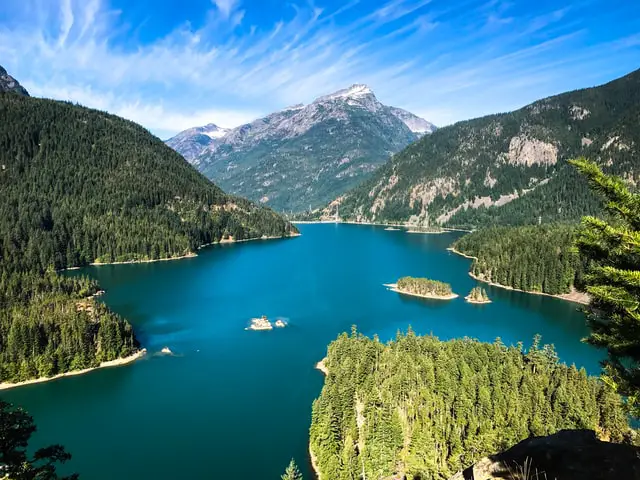
Don Pedro Reservoir is a large lake that sits 142 miles away from San Francisco and 315 miles from Los Angeles. Nestled in the Sierra Nevada Foothills, just east of Modesto, it’s California’s fifth-largest reservoir in the state. Overall it’s a quiet lake being nestled in a part of the western part of the state. If you’re visiting Yosemite National Park, you can also stop by, relax and get your line wet at this beautiful reservoir. In this post, you’re going to be given the blueprint to fish this lake.
So what are the best tips for fishing Don Pedro Reservoir? There are three important factors you must know if you want to know how to fish Don Pedro Reservoir successfully. First, you need to know what kind of fish is in Don Pedro Reservoir. Second, it’s important for you to know which part of the lake each species can be found in. Lastly, knowing what are the best baits that work on Don Pedro Reservoir is vital. However, tactics, baits, and locations will be different for each type of fish that you target. So let’s talk about the steps you need to take in order to give you the best chance of catching a fish in Don Pedro Reservoir.
WARNING: There’s a lot of information about this subject you’ll probably want to come back to. No one expects you to remember all these tips. We know your time is precious, so we really tried to over-deliver in value for you. Additionally, we frequently update reports like this, so you’ll want to stay up to date with any changes or additional tips we include for you.
We found that the easiest way to save and bookmark this report so you can come back to it later is to share it on your favorite social media platform, especially if you use your phone to get important tips like the ones in this report here…
Click on your favorite social media buttons to remember this page now!
About Don Pedro Reservoir
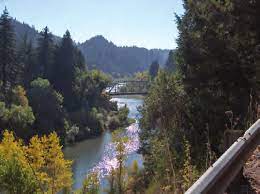 Don Pedro Reservoir is a deep body of water with the average depth being 45 feet and a maximum depth of 500 feet when the lake is completely full. The reservoir’s coastline is roughly 160 miles long when full and spans over 13,000 acres.
Don Pedro Reservoir is a deep body of water with the average depth being 45 feet and a maximum depth of 500 feet when the lake is completely full. The reservoir’s coastline is roughly 160 miles long when full and spans over 13,000 acres.
This reservoir naturally has incoming water from a nearby water shed that is over 1,500 square miles long.
It also plays a vital role in supplying local farmland irrigation water to be utilized by the Modesto Irrigation District (MID) and the Turlock Irrigation District (TID). Originally created in 1923, additionally, a larger expansion dam was built and completed in 1971.
Don Pedro Reservoir gives locals and visitors the opportunity to test their luck in catching one of the many game species this lake has to offer, such as Trout, Bass, Kokanee Salmon, King and Silver Salmon, Crappie, Catfish, Bluegill and Sunfish!
Important Lake Warnings
Algae blooms may be present which may affect fishing, swimming, and water contact in general.
According to parks.ca.gov, “every one of California’s new laws requires boat operators to have a California Boating Card. The card is required for anyone under the age of 41 to operate a boat in California’s waters.”
If you are fishing and camping, fire bans may be in effect due to the ongoing drought conditions.
What Kind of Fish Are In Don Pedro Reservoir
- Rainbow Trout
- Brown Trout
- Brook Trout
- Chinook/King Salmon
- Kokanee Salmon
- Largemouth Bass
- Smallmouth Bass
- Spotted Bass
- White and Black Crappie
- Bluegill and Sunfish
- Perch
- Catfish
Don Pedro Reservoir Fishing Tips & General Strategies
It can be a challenge to break down Don Pedro Reservoir and decide where to get started.
However, Normally in the summer there would be bunches of boats out trolling for trout, salmon, or kokanee fishing every day in the middle of the summer. The drought, on the other hand, is constantly mentioned by politicians, newspapers, and bloggers.
People haven’t been visiting the lake or chartering guided fishing trips because they believe there isn’t any water left for the fish to live in!
Most of the fish such as bass, bluegill, crappie, and catfish will spawn in the spring. Bass will spawn in 1’-15’-feet of water notably on rocky structure, gravel flats, humps, and small creek inlets and cuts.
If you can find the ideal spot at the ideal depth then it will most likely assist you in catching fish.
But where are the best places to fish At Don Pedro Reservoir?
And in no particular order here is that list of the best fishing spots at Don Pedro Reservoir.
DISCLAIMER: The material provided is for general information purposes only. It’s important to understand that any information provided in this article can change at any time. Any maps or graphics featured are not to be used as navigational aids. Fishing Blueprint will not be responsible for any personal injury or property damage from any misuse of the maps or graphics provided. It’s completely impossible to give you every single spot where you can potentially catch a fish. But, what this list does do is to give you a helping hand and narrow down to the most productive fishing spots.
West Bay (Blue Oaks, Mexican Gulch, Fleming Meadows)

This area of the lake is very deep and can be an excellent place to troll for lake trout and salmon, especially in the summer.
Downriggers and drift socks aid in catching these trout that are suspended over deep water 80-150-feet deep during the late springtime all the way through late summertime.
Graph this area from the “mouth” Blue Oaks Recreation Area, through Mexican Gulch (in front of the dam) all the way to the Fleming Meadows Recreation area.
Some of the effective baits for this area include:
But wait! Before you tie on any bait nearly every professional fishing guide will strongly encourage the use of a fish attractor like a quality flasher or dodger 2-3 feet in front of any lure. This helps get the fish’s attention, kinda like ringing a dinner bell!
Trolling spoons such as a Krocodile spoon, Super Duper, Crippled Herring, Cast Champ, or Hus-Lure. Trolling spoons have an unpredictable, minnow-like motion that delivers bone-crushing strikes. Even the slowest current brings these lures to life. Add extra motion by twitching the rod tip and enabling the bait to pop and dart forward and flutter back.
Inline spinners such as the Bang-Tail and Shyster are non-twist spinners that boast an immediate spin blade design for incredibly rapid start-ups and the best slow retrieve performance.
Many anglers also place their confidence in the Blue Fox Classic Vibrax inline spinner. This little bait is a compact shallow running lure that performs best in 2 to 6 feet of water, depending on the speed of the retrieve or trolling speed. The patented two-part body emits low-frequency sound vibrations that attract fish. This lure is best used in lakes, rivers, and streams.
Minnow style baits also work very well either cast-and-retrieved or trolled. These perform best if the water is clear/slightly stained. The Luhr-Jensen Quick Fish and the Rapala BX minnow are constructed from hard plastic, have a wide wobble action, and are extremely durable. Whereas the Rapala Original Floating Minnow and the Ultra Light Minnow (all are slow sinking) both give you a tighter wobble perfect for clear water and pressured fishing conditions.
Better yet, just buy a complete done-for-you trout lure kit!
Now if you’re fishing from the shore, kayak, or even from the shore you should also consider using these additional baits:
- Real or artificial corn – great because it will never spoil or mold over
- Natural salmon eggs – it’s hard to beat natural salmon eggs when trout are eating salmon eggs, they’ll eat up jars of this stuff!
- Artificial salmon eggs – great because they float off the bottom – ideal in rocky or grassy conditions
- Real worms – such as meal worms or nightcrawlers
- Artificial worms – great for trolling and will never die)
- Dough bait – great because they stay on the hook really well, it floats if you put enough on the hook, comes in a variety of colors and scents.
- Wet flies (sinking flies) – Wet flies imitate insects that develop and inhabit below the water level before emerging and rising to the surface.
- Woolly bugger flies – One of the most popular fly patterns ever is the Woolly Bugger. These mimic small fish, leeches, larvae, and worms.
.
Oh, before I forget, did you know that there is an article about how to troll for salmon, trout, and kokanee the right way? Go here to find out more.
Located: Southwest corner of the lake
Structural features: Steep clay and rocky banks, deep channels and drop offs.
Best species to target: Trout and salmon
The most effective way to fish this spot: Shoreline, float tube, kayak, or boat Trolling with a downrigger, trolling without a down rigger
Jenkins Hill
Jenkins Hill is located between West Bay and South Bay.
One of its defining features is it is incredibly steep and drops into 300+ feet of water which makes this an excellent place to troll for cold-water fish like kokanee, lake trout, and king salmon.
Look Closely…

Downriggers and drift socks aid in catching these trout that are suspended over deep water 80-150-feet deep during the late springtime all the way through late summertime.
Some of the effective baits for this area include: Fish attractor (ie: flasher or dodger), trolling spoons, inline spinners, Rapala minnows, Quick Fish, streamers and flies. You can also use real or artificial corn, natural salmon eggs, artificial salmon eggs, real worms such as meal worms or nightcrawlers, artificial worms, and dough bait. Better yet, just buy a complete done-for-you trout lure kit!
Located: between West Bay and South Bay.
Structural features: Steep clay and rocky banks, deep channels and drop offs.
Best species to target: Trout and salmon
Most effective way to fish this spot: Boat Trolling with a downrigger, trolling without a downrigger
Rocky Banks on Middle Bay
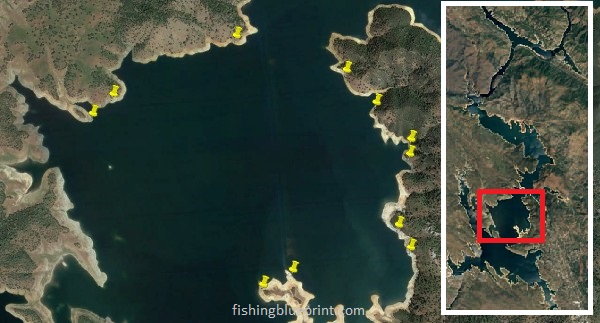
If you analyze the banks of Middle Bay and into Graveyard Creek you’ll notice isolated patches of chunk rock banks.
The banks can range from moderate to relatively steep and can range from large boulders, to chunk rock, to pea-sized substrate.
Look Closely…

Side scanning this area for active fish such as all species of trout and smallmouth bass should be a must if you plan to fish this lake.
Surprisingly, this area remains relatively quiet for recreational fishing traffic, due to the fact that most other anglers will either focus on the north or south end of the lake.
Effective baits for trout and salmon in this area include: Fish attractor (ie: flasher or dodger), trolling spoons, inline spinners, Rapala minnows, Quick Fish, streamers and flies. You can also use real or artificial corn, natural salmon eggs, artificial salmon eggs, real worms such as meal worms or nightcrawlers, artificial worms, and dough bait. Better yet, just buy a complete done-for-you trout lure kit!
Effective baits for bass this area include: topwater lures, flutter spoons, buzzbaits, crankbaits, soft plastic swimbaits, spinnerbaits, chatterbaits, jerkbaits, swim jigs, hair jigs, and underspin jigs when the bass are aggressive.
If the bass are timid, then drop shot, tubes, Ned rig, Neko rig, Mojo rig, Carolina rig, and football jigs all work really well.
Located: Mid-lake
Structural features: Steep rocky banks, drop offs, and ledges
Best species to target: Bass, trout
Most effective way to fish this spot: Boat
Big Creek & West Fork Big Creek

This area is great year-round.
The long creek serves as a deep feeder arm into the lake. At times the fishing here can be extremely good. Sometimes you can catch a boatload of fish in less than an hour.
The north end of the cove holds submerged brush and timber which can be good for largemouth bass, smallmouth bass, spotted bass, bluegill, and crappie.
At the middle of the cove and at the mouth is great for largemouth and spotted bass. This also has a deep channel with many drop offs and it’s great for night fishing for catfish and crappie.
In the summer you have the option to fish at the mouth of the cove targeting isolated humps, rock piles, and ledges. Or you can travel up the river and flip laydowns and fish over standing timber.
Always have a topwater bait tied on; these bass love to chase shad to the surface, so either a topwater popper, walking bait, or buzzbait should be considered.
Effective baits for this area include: topwater lures, flutter spoons, buzzbaits, crankbaits, soft plastic swimbaits, spinnerbaits, chatterbaits, jerkbaits, swim jigs, hair jigs, and underspin jigs when the bass are aggressive.
If the bass are timid, then drop shot, tubes, Ned rig, Neko rig, Mojo rig, Carolina rig and football jigs are awesome choices.
If you scan the deeper sections of this area you’ll find clumps of submerged timber in 20-30-feet of water. This is where you’ll find crappie holding above the trees.
To catch these crappies, slow troll live minnows, roadrunner head jigs, and crappie tubes.
In the spring, checking 49’er Bay (extends off Big Creek) for spawning bass can yield massive results.
Moreover, Don Pedro Reservoir can be very windy, it’s strongly recommended to use a quality drift sock to help slow your drift so you don’t have to worry about using up all your trolling motor battery power.
Located: Southwest end of the lake
Structural features: Submerged brush and timber, rocky points, deep channel, channel swings, ledges, and drop offs,
Best species to target: Largemouth bass, smallmouth bass, spotted bass, catfish, bluegill, and crappie
Most effective way to fish this spot: Boat
Mud Flat Bay

Located on the southwest section of the lake, this area is a relatively shallow bay.
The mouth of the cove is excellent for largemouth bass, crappie, and spotted bass along the drop off, especially when the water is low.
The cove holds a large flood plane with a good amount of submerged brush and timber, along with submerged humps.
Look Closely…
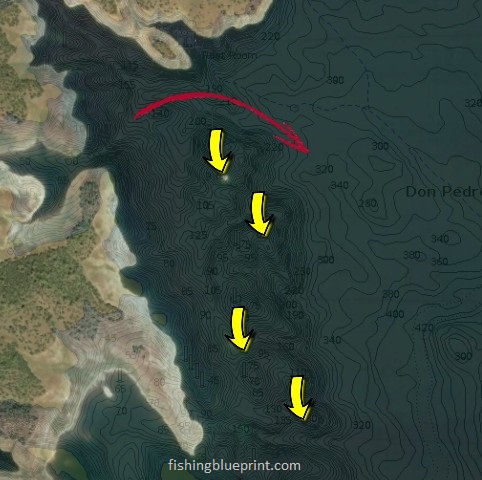
In the back of the cove, there are several feeder creeks and small washes that are excellent for largemouth bass, smallmouth bass, crappie, and bluegill.
By the way, these same feeder creeks are also great for nighttime catfishing.
Effective baits for this area include: topwater lures, flutter spoons, buzzbaits, crankbaits, soft plastic swimbaits, spinnerbaits, chatterbaits, jerkbaits, swim jigs, hair jigs, and underspin jigs when the bass are aggressive.
If the bass are timid, then drop shot, tubes, Ned rig, Neko rig, Mojo rig, Carolina rig and football jigs all work really well.
Located: Southwest end of the lake
Structural features: Submerged brush and timber, submerged humps, feeder creeks
Best species to target: Largemouth bass, smallmouth bass, spotted bass, catfish, bluegill, and crappie
Most effective way to fish this spot: Boat, kayak, float tube. Shore fishing is also really good.
Green Bay

This is another spot that has several unique features for bass anglers.
It’s unique because it has a single deep channel that extends into the main lake. Additionally, the northern side is steep and rocky, conversely, the opposite side can be characterized as a more gentle sloping area that gives anglers a large number of laydowns and isolated rock piles to target.
This area should also be checked for spawning bass in the spring.
Some of the effective baits for trout and salmon this area include: Fish attractor (ie: flasher or dodger), trolling spoons, inline spinners, Rapala minnows, Quick Fish, streamers and flies. You can also use real or artificial corn, natural salmon eggs, artificial salmon eggs, real worms such as meal worms or nightcrawlers, artificial worms, and dough bait. Better yet, just buy a complete done-for-you trout lure kit!
Effective baits for this area include: topwater lures, flutter spoons, buzzbaits, crankbaits, soft plastic swimbaits, spinnerbaits, chatterbaits, jerkbaits, swim jigs, hair jigs, and underspin jigs when the bass are aggressive.
If the bass are timid, then drop shot, tubes, Ned rig, Neko rig, Mojo rig, Carolina rig and football jigs all work really well.
Located: West end of the lake
Structural features: Combination of steep and sloping banks, rocky banks, isolated rock piles, stumps and laydowns
Best species to target: Largemouth bass, smallmouth bass, spotted bass, catfish, bluegill, and crappie
Most effective way to fish this spot: Boat
Willow Creek
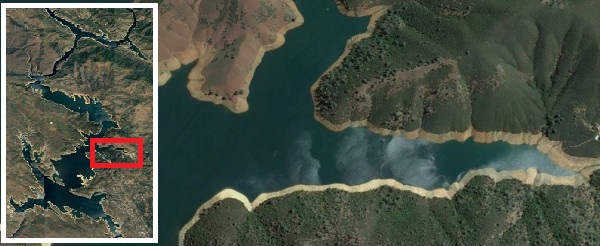
This special area of the lake gives the anglers a long single deep channel to fish.
This is an excellent place to troll for lake trout and salmon, especially in the summer.
Downriggers and drift socks aid in catching these trout that are suspended over deep water 80-150-feet deep during the late springtime all the way through late summertime.
Some of the effective baits for this area include: Fish attractor (ie: flasher or dodger), trolling spoons, inline spinners, Rapala minnows, Quick Fish, streamers and flies. You can also use real or artificial corn, natural salmon eggs, artificial salmon eggs, real worms such as meal worms or nightcrawlers, artificial worms, and dough bait. Better yet, just buy a complete done-for-you trout lure kit!
Located: Southwest corner of the lake
Structural features: Steep clay and rocky banks, deep channels and drop offs.
Best species to target: Trout and salmon
Most effective way to fish this spot: Shoreline, float tube, kayak or boat Trolling with a downrigger, trolling without a down rigger
Gardiner Falls

Gardiner Falls is located mid-lake in the northeast corner of Upper Bay.
It’s unique for a few reasons.
(1) After it rains fishing in this area can be gangbusters!
(2) The natural terrain creates a steep bluff wall-like appearance and since the coves are very narrow it creates a natural funnel filled with drop offs, ledges, huge boulders, and rock piles.
(3) You’ll observe deep feeder cuts west. Well most of the time wind blows in from the west. The westerly wind pushes floating debris across the lake and makes floating debris mats making it a phenomenal area to flip and punch lures through.
(4) Lastly, anglers who fish this area and are successful will target the large feeder creeks and channels with submerged brush and timber. The deeper areas are great to hold bass and crappie.
Some of the effective baits for trout and salmon this area include: Fish attractor (ie: flasher or dodger), trolling spoons, inline spinners, Rapala minnows, Quick Fish, streamers and flies. You can also use real or artificial corn, natural salmon eggs, artificial salmon eggs, real worms such as meal worms or nightcrawlers, artificial worms, and dough bait. Better yet, just buy a complete done-for-you trout lure kit!
Effective baits for this area include: topwater lures, buzzbaits, crankbaits, soft plastic swimbaits, chatterbaits, spinnerbaits, jerkbaits, swim jigs, hair jigs, and underspin jigs when the bass are aggressive.
Flutter spoons work great by “hopping” the spoon from one ledge and letting it fall to the next one down underneath it. How high you hop the spoon off the ledge will depend on how aggressive the bass are. The more aggressive = higher the hop versus less aggressive bass will only need a small hop off the ledge.
If the bass are timid, then drop shot, tubes, wacky rigged senko, Mojo rig, Texas rig, Ned rig, Neko rig, Mojo rig, Carolina rig, and football jigs all work really well.
Located: Mid lake (east side)
Structural features: Rocky structure, feeder creeks, submerged standing timber
Best species to target: Bass, bream, crappie, and catfish
Most effective way to fish this spot: Boat
Moccasin Point Recreation Area
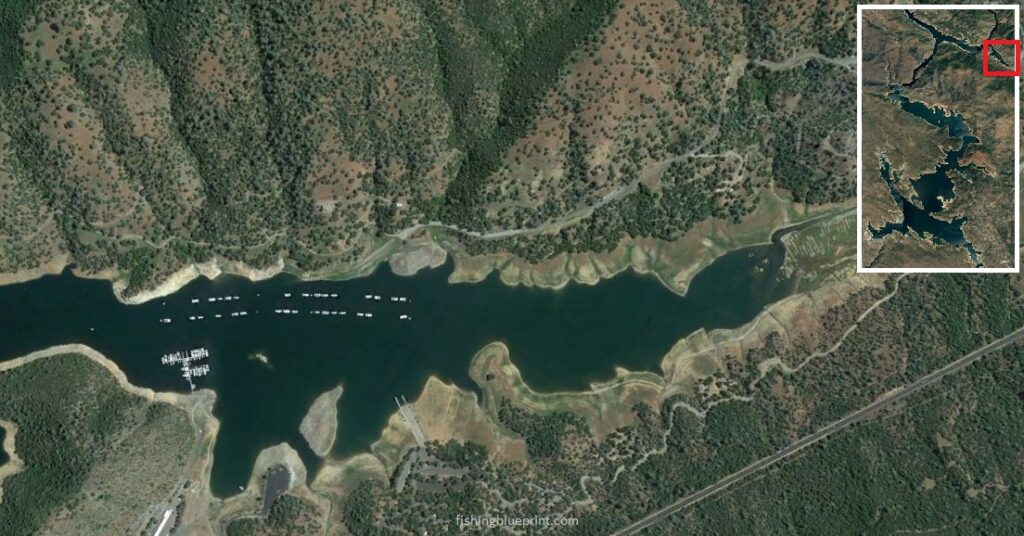
Moccasin Point Recreation Area fishes like a small lake attached to the main body of water. The big cove connects to the Tuolumne River arm that’s adjacent to the marina.
Scan this area with a fish finder if you’re fishing from the pier because of the large amount of artificial habitat placed around this area.
Additionally, there are large isolated rock piles in this area that should be scanned and fished.
Lastly, any large rock to smaller-sized rock transitions also tends to hold fish. If found, make sure to take your time is fish it well.
Look Closely…
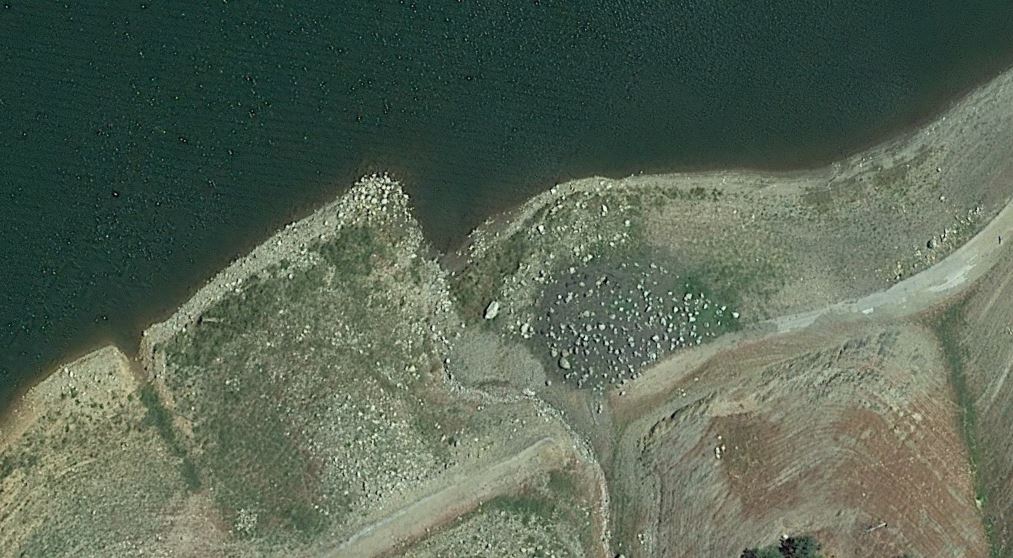
Fish around the habitat or structure if you see shad or bluegill in the area.
Fish the perimeter of Moccasin Marina, particularly targeting mud-to-rock transitions with a dropshot, white fluke, spinnerbait, or a jerkbait.
This is a great area for shore anglers, float tubes, kayak fishing and of course boats.
For shore anglers, make sure you pick up a portable fish-finder to find all the best fishing spots.
Effective baits for this area include: topwater lures, buzzbaits, crankbaits, soft plastic swimbaits, spinnerbaits, jerkbaits, chatterbaits, swim jigs, hair jigs, and underspin jigs when the bass are aggressive. Flutter spoons work great in the deeper channel sections as well.
If the bass are timid, then drop shot, tubes, Ned rig, Neko rig, Mojo rig, Carolina rig and football jigs all work really well.
Located: Northwest corner, just east to the Moccasin Point Marina
Structural features: Shoreline fishing, artificial submerged structure, grass flats, shadow cuts, rock piles, and boulders.
Best species to target: Largemouth bass, smallmouth bass, spotted bass, catfish, bluegill, and crappie
Most effective way to fish this spot: Boat, kayak, float tube. Shore fishing is also really good.
Woods Creek
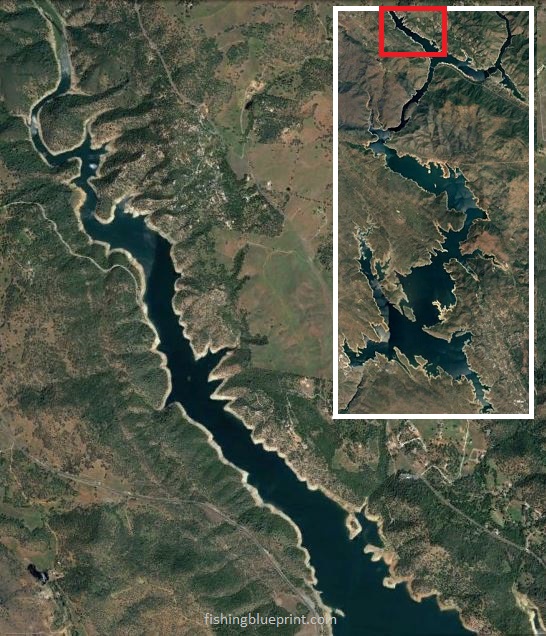
Located on the northwest section of the lake Woods Creek is a long winding channel that is excellent for largemouth bass, smallmouth bass, spotted bass, crappie, and catfish… especially when the water is low.
The channel holds a large amount of submerged brush and standing timber, along with submerged humps, and sharp channel swings.
Look Closely…

Effective baits for this area include: topwater lures, buzzbaits, crankbaits, soft plastic swimbaits, spinnerbaits, jerkbaits, chatterbaits, swim jigs, hair jigs, and underspin jigs when the bass are aggressive. Flutter spoons work great in the deeper channel sections as well.
If the bass are timid, then drop shot, tubes, Ned rig, Neko rig, Mojo rig, Carolina rig and football jigs all work really well.
Located: Northwest end of the lake
Structural features: Submerged brush and timber, submerged humps, channel swings
Best species to target: Largemouth bass, smallmouth bass, spotted bass, catfish, bluegill, and crappie
Most effective way to fish this spot: Boat
How To Catch Fish In Don Pedro Reservoir
Rainbow Trout
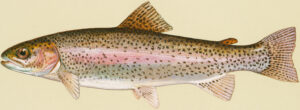 California Department of Fish and Wildlife grows and stocks local lakes and reservoirs like this lake with Rainbow Trout.
California Department of Fish and Wildlife grows and stocks local lakes and reservoirs like this lake with Rainbow Trout.
Due to this lake being relatively unpressured, deep, and colder, and most other desert reservoirs, the stocked trout do very well.
Furthermore, trout are produced in local fisheries, they are healthy and have no limit on the amount of trout that can be consumed.
Typically trout are stocked frequently, however, it can vary.
Sometimes you’ll read this lake has steelhead trout, but no rainbow trout, or visa versa…
This can be confusing for a lot of people. Are rainbow trout and steelhead trout the same?
Short answer, they are nearly the same species.
But, if you have ever wondered, what is the real difference between a rainbow trout and a steelhead trout? We wrote a definitive report called, “What’s the Difference Between A Rainbow Trout Vs Steelhead”. Click here to read it, so you can end the confusion once and for all.
General Trout Details
Spawn: March-May
Food: insects and crustaceans.
California State Record: 27 lbs 0 oz. Caught 10/02/2005 in Lake Natoma.
Table Quality: Depending on the fishes diet, the meat can be white to orange-red in color. The meat is firm, flaky, and is considered excellent eating.
Angling techniques:
- Trolling with or without downriggers
- Fish attractor such as a flasher or a dodger – great when trolling.
- Trolling spoons such as a Krocodile spoon, Super Duper, Crippled Herring, Cast Champ, or Hus-Lure – simple, easy to use, can be trolled or cast-retrieved at any speed.
- Inline spinners such as the Bang-Tail and Shyster – gets a ton of bites.
- Minnow style baits such as the Luhr-Jensen Quick Fish and the Rapala BX minnow – known to hook up giant fish.
- Real or artificial corn – great because it will never spoil or mold over.
- Natural salmon eggs – it’s hard to beat natural salmon eggs at bait. When trout are eating salmon eggs, they’ll eat up a couple of jars in less than an hour!
- Artificial salmon eggs – great because they float off the bottom – ideal in rocky or grassy conditions.
- Real worms – such as meal worms or nightcrawlers.
- Artificial worms – great for trolling and will never die.
- Dry flies (floating flies) – The insects that land, float, or live on top of the water, which are represented by dry flies. Investing in a kit gives you a wide assortment of flies and a good selection of types and sizes allow you to quickly adjust to any situation.
- Wet flies (sinking flies) – Wet flies imitate insects that develop and inhabit below the water level before emerging and rising to the surface. Investing in a kit gives you a wide assortment of flies and a good selection of types and sizes allow you to quickly adjust to any situation.
- Woolly bugger flies – One of the most popular fly patterns ever is the Woolly Bugger. These mimic small fish, leeches, larvae, and worms. Investing in a kit gives you a wide assortment of flies and a good selection of types and sizes allow you to quickly adjust to any situation.
Steamer flies – They can also mimic larger animals found in streams and rivers, including crawfish, larger leeches, and smaller fish. Investing in a kit gives you a wide assortment of flies and a good selection of types and sizes allow you to quickly adjust to any situation.
- **The number one key to successful trout fishing, is to use light line (2 to 6 pound) and small hooks (10-14 sizes), and small sinkers
Brown Trout
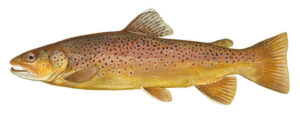 In California, this is the only fish with both red and black patches on its body.
In California, this is the only fish with both red and black patches on its body.
A pale/off-white halo usually surrounds dark patches on the sides.
On the back, the color ranges from dark to olive brown, dipping to yellow on the sides, and yellow or white on the belly.
In larger fish, breeding males have lower chin that will create a hooked jaw. The corner of the mouth extends past the eye, resulting in a huge mouth.
Brown trout are not native to California, nor to North America for that matter. They were first imported to California in 1893 and originated in Europe.
Brown trout will commonly feed during the day if they are not bothered. Larger fish, on the other hand, are mainly nocturnal.
Brown trout are very aggressive feeders and will readily eat a streamer fly, casting upstream or into the wind.
Artificial baits such as in-line spinners or small Rapala minnow bait work phenomenally.
Live nightcrawlers, or minnows on a #6-#8 hooks are excellent baits.
If you can find any waterfall or spillway, spend some time fishing it because brown trout will often wait to ambush any prey that happens to drift over them in those areas.
Likewise, if you’re in a boat on the main lake some of the best ways to catch brown trout is to troll for these behemoths.
General Trout Details
Spawn: October-December
Food: Insects, small fish and crustaceans.
California State Record: 26 lbs 8 oz. Caught 04/30/1987 in Twin Lakes.
Table Quality: Depending on the fishes diet, the meat can be white to orange-red in color. The meat is firm, flaky, and is considered excellent eating.
Angling techniques:
- Trolling with or without downriggers
- Trolling flies
- Worms
- Salmon eggs
- Powerbait
- Corn
- Cheese
- Marshmallows
- Spinners
- Spoons
- Flies
- *The number one key to successful trout fishing, is to use light line (2 to 6 pound) and small hooks (10-14 sizes), and small sinkers
Brook Trout
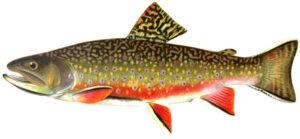 Brook trout are the only fish in California with a vermiculate appearance on their backs and upper sides that appears wavy, almost worm-like.
Brook trout are the only fish in California with a vermiculate appearance on their backs and upper sides that appears wavy, almost worm-like.
They have red specks encircled by blue halos and are olive-green to olive-brown in color, with reddish tints.
Pectoral, pelvic, and anal fins with white-leading edges are the most prominent features of a brook trout.
Brook trout are opportunistic eaters who eat tiny crawfish, worms, minnows, and terrestrial and aquatic invertebrates.
They eat whatever is accessible to them. Anglers love them because they can accept a variety of flies and lures and are not as finicky as other species of trout.
Brook trout fishing is comparable to rainbow trout fishing in rivers or lakes.
Brook trout love spinners. The best spinners are: Bang-Tail (size 018), Blue Foxes (blade size-0), Kastmasters (1/16-ounce), Panther Martins spinners, Little Cleo spoons (1/16-ounce), and Shyster spinners (size 018).
Worms and natural bugs like grasshoppers, woolly buggers, and floating flies are great patterns to consider.
General Brook Trout Details
Spawn: October-November
Food: Insects, small fish, and crustaceans.
California State Record: 9 lbs 12 oz. Caught 09/99/1932 in Silver Lake.
Table Quality: Depending on the fishes diet, the meat can be white to orange-red in color. The meat is firm, flaky, and is considered excellent eating.
Angling techniques:
- Trolling with or without downriggers
- Fish attractor such as a flasher or a dodger – great when trolling.
- Trolling spoons such as a Krocodile spoon, Super Duper, Crippled Herring, Cast Champ, or Hus-Lure – simple, easy to use, can be trolled or cast-retrieved at any speed.
- Inline spinners such as the Bang-Tail and Shyster – gets a ton of bites.
- Minnow style baits such as the Luhr-Jensen Quick Fish and the Rapala BX minnow – known to hook up giant fish.
- Real or artificial corn – great because it will never spoil or mold over.
- Natural salmon eggs – it’s hard to beat natural salmon eggs when trout are eating salmon eggs, they’ll eat up jars of this stuff!
- Artificial salmon eggs – great because they float off the bottom – ideal in rocky or grassy conditions.
- Real worms – such as meal worms or nightcrawlers.
- Artificial worms – great for trolling and will never die.
- Dry flies (floating flies) – The insects that land, float, or live on top of the water, which are represented by dry flies.Investing in a kit gives you a wide assortment of flies and a good selection of types and sizes allow you to quickly adjust to any situation.
- Wet flies (sinking flies) – Wet flies imitate insects that develop and inhabit below the water level before emerging and rising to the surface. Investing in a kit gives you a wide assortment of flies and a good selection of types and sizes allow you to quickly adjust to any situation.
- Woolly bugger flies – One of the most popular fly patterns ever is the Woolly Bugger. These mimic small fish, leeches, larvae, and worms. Investing in a kit gives you a wide assortment of flies and a good selection of types and sizes allow you to quickly adjust to any situation.
Steamer flies – They can also mimic larger animals found in streams and rivers, including crawfish, larger leeches, and smaller fish. Investing in a kit gives you a wide assortment of flies and a good selection of types and sizes allow you to quickly adjust to any situation.
- **The number one key to successful trout fishing, is to use light line (2 to 6 pound) and small hooks (10-14 sizes), and small sinkers
Chinook “King” Salmon
These landlocked 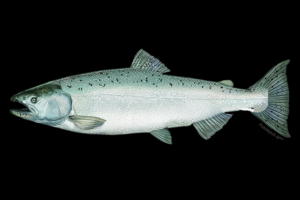 salmon (commonly called King Salmon because they are the largest species of salmon found in the Pacific), with some fish weighing in at 10 to 12 pounds! However, most of the fish will weigh in around 2-4-pounds.
salmon (commonly called King Salmon because they are the largest species of salmon found in the Pacific), with some fish weighing in at 10 to 12 pounds! However, most of the fish will weigh in around 2-4-pounds.
These fish may be found in deep water (40-80-feet) throughout the year, but they are particularly abundant in the main channel near the dam in March. Try trolling with live anchovies or shad, as well as shad-like lures and spoons.
In the summer and fall, trolling shad is the easiest method to capture huge salmon and trout.
Salmon and trout chase shad to the surface, which is one of the most well guarded secrets.
If you notice them eating bait balls, you have to start trolling shad or something that can come close to matching the hatch.
Sure, worms and egg sacks will catch them, but why not make it simpler on yourself and troll what they eat the most?
Shad is a natural food source for these landlocked monsters.
In a typical California reservoir, shad may be found in the vast majority of them, otherwise minnows and other small baitfish will work just fine
General King Salmon Details
Spawn: September – December
Food: Insects, small crustaceans, shad or other small fish.
California State Record: 65 lbs 4 oz. Caught 8/21/2002 in Crescent City.
Table Quality: Depending on the fishes diet, the meat can be white to orange-red in color. The meat is firm, flaky, and is considered excellent eating.
Angling techniques:
- Trolling with or without downriggers
- Fish attractor such as a flasher or a dodger – great when trolling.
- Trolling spoons such as a Krocodile spoon, Super Duper, Crippled Herring, Cast Champ, or Hus-Lure – simple, easy to use, can be trolled or cast-retrieved at any speed.
- Inline spinners such as the Bang-Tail and Shyster – gets a ton of bites.
- Minnow style baits such as the Luhr-Jensen Quick Fish and the Rapala BX minnow – known to hook up giant fish.
- Real or artificial corn – great because it will never spoil or mold over.
- Natural salmon eggs – it’s hard to beat natural salmon eggs when trout are eating salmon eggs, they’ll eat up jars of this stuff!
- Artificial salmon eggs – great because they float off the bottom – ideal in rocky or grassy conditions.
- Real worms – such as meal worms or nightcrawlers.
- Artificial worms – great for trolling and will never die.
- Dry flies (floating flies) – The insects that land, float, or live on top of the water, which are represented by dry flies.Investing in a kit gives you a wide assortment of flies and a good selection of types and sizes allow you to quickly adjust to any situation.
- Wet flies (sinking flies) – Wet flies imitate insects that develop and inhabit below the water level before emerging and rising to the surface. Investing in a kit gives you a wide assortment of flies and a good selection of types and sizes allow you to quickly adjust to any situation.
- Woolly bugger flies – One of the most popular fly patterns ever is the Woolly Bugger. These mimic small fish, leeches, larvae, and worms. Investing in a kit gives you a wide assortment of flies and a good selection of types and sizes allow you to quickly adjust to any situation.
Steamer flies – They can also mimic larger animals found in streams and rivers, including crawfish, larger leeches, and smaller fish. Investing in a kit gives you a wide assortment of flies and a good selection of types and sizes allow you to quickly adjust to any situation.
- **The number one key to successful trout fishing, is to use light line (2 to 6 pound) and small hooks (10-14 sizes), and small sinkers
Kokanee Salmon
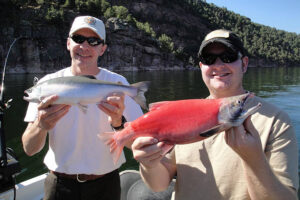 The landlocked Sockeye salmon are known as Kokanee.
The landlocked Sockeye salmon are known as Kokanee.
Kokanee salmon mature in lakes or reservoirs and move into streams in the fall to spawn, whereas Sockeye salmon mature in the ocean and migrate into streams.
Kokanee were initially introduced to California waters as fingerlings in 1941.
While our drought is a serious issue that is unlikely to go away anytime in the near future, there is more than enough water to target kokanee.
Yes, the water level is at 50%, and the fish are not holding over the traditional fishing spots.
So it’s just a matter of fishing the right locations at the right depth…
That’s where having the right electronics really helps.
We anglers must work harder than we’re used to in order to catch these cold-water beauties.
Kokanee can be caught dodgers, spinners, spoons, and even simple red hooks.
To attract the attention of the fish, anglers will tip their spinners and spoons with bits of corn or use an attractant.
Because this fish has a mouth full of sharp teeth which can easily cut a line, a lead leader is strongly recommended.
Kokanee will be seeking cooler water in June, which will most likely be 100-200-feet water depth, so trolling with a downrigger is absolutely a must.
By the way, if you don’t know how to use a downrigger, that’s okay! A lot of fishing guides we talked to don’t like to talk about such an effective way to fish. Regardless, you deserve to know… click here to learn more
General Kokanee Details
Spawn: September – December
Food: Zooplanton, insects, small crustaceans, shad or other small fish.
California State Record: 5 lbs 2 oz. Caught 7/20/2013 in Lake Tahoe.
Table Quality: Depending on the fishes diet, the meat can be white to orange-red in color. The meat is firm, flaky, and is considered excellent eating.
Angling techniques:
- Trolling with or without downriggers
- Fish attractor such as a flasher or a dodger – great when trolling.
- Trolling spoons such as a Krocodile spoon, Super Duper, Crippled Herring, Cast Champ, or Hus-Lure – simple, easy to use, can be trolled or cast-retrieved at any speed.
- Inline spinners such as the Bang-Tail and Shyster – gets a ton of bites.
- Minnow style baits such as the Luhr-Jensen Quick Fish and the Rapala BX minnow – known to hook up giant fish.
- Real or artificial corn – great because it will never spoil or mold over.
- Natural salmon eggs – it’s hard to beat natural salmon eggs when trout are eating salmon eggs, they’ll eat up jars of this stuff!
- Artificial salmon eggs – great because they float off the bottom – ideal in rocky or grassy conditions.
- Real worms – such as meal worms or nightcrawlers.
- Artificial worms – great for trolling and will never die.
- Dry flies (floating flies) – The insects that land, float, or live on top of the water, which are represented by dry flies.Investing in a kit gives you a wide assortment of flies and a good selection of types and sizes allow you to quickly adjust to any situation.
- Wet flies (sinking flies) – Wet flies imitate insects that develop and inhabit below the water level before emerging and rising to the surface. Investing in a kit gives you a wide assortment of flies and a good selection of types and sizes allow you to quickly adjust to any situation.
- Woolly bugger flies – One of the most popular fly patterns ever is the Woolly Bugger. These mimic small fish, leeches, larvae, and worms. Investing in a kit gives you a wide assortment of flies and a good selection of types and sizes allow you to quickly adjust to any situation.
Steamer flies – They can also mimic larger animals found in streams and rivers, including crawfish, larger leeches, and smaller fish. Investing in a kit gives you a wide assortment of flies and a good selection of types and sizes allow you to quickly adjust to any situation.
- **The number one key to successful trout fishing, is to use light line (2 to 6 pound) and small hooks (10-14 sizes), and small sinkers
On a Side Note: Tips For Trolling for Trout, King Salmon, or Kokanee
If you have access to a boat or kayak, try to put as many lures in the water as possible (obviously, check local laws, regulations, and restrictions, as well as knowing if certain locations have limits) and as far away from the boat as feasible.
Some utilize planer boards and even down riggers to keep the lines away from the boat.
Here’s where a smart professional fishing-guide can and will hook you up with some of the biggest, toughest-fighting fish you’ll ever encounter.
Having high-quality electronics aids in establishing the depth at which fish are continuously feeding, as well as which food source is being consumed the most frequently.
If you examine the shoreline’s structure along with using your fish finder, study the underwater topography of the lake.
If you notice a cliff, it’s likely that the water at its base is deep.
If you observe a chain of islands or exposed main lake humps, there’s a good chance there’s a shallow shoal or channel between them.
Trout prefer drop-offs, channels, and ledges, so you’ll want to troll parallel to these locations rather than over them.
If you stumble upon a place and catch a trout, there’s a good chance there are more.
Luckily there is an in-depth report that you can access, called How To Troll for Trout [A Beginner’s Guide], you’ll learn all the special tips and strategies many of the fishing guides will keep to themselves. Click here to learn more, so you can extend your fishing season all year long.
Largemouth Bass
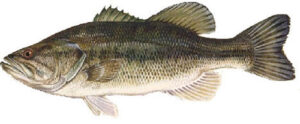 Largemouth bass is a carnivorous member of the sunfish family.
Largemouth bass is a carnivorous member of the sunfish family.
California grows some MONSTER bass. At any time you could hook into a bass that could be your all-time personal best.
In general, if the water clarity is clear to a slightly stained lake. Meaning finesse techniques (like drop shot fishing), small lures (like football jigs), and thin diameter line gets you the most bites when the wind is calm.
On the other hand, if the water is moderately stained or murky, then you need to choose darker lures. This also means you can get away with using thicker diameter line.
Since the 1980’s this lake has been stocked with Florida-strain largemouth bass. Bass fishing in this lake is not as popular as trout or salmon fishing. Luckily, you can still catch a giant bass by lobbying large swimbaits for glide baits in trout patterns.
Once your arm gets tired you can still catch a ton of fish by throwing a drop shot rig, small crankbait, or dragging a Texas rigged Senko around a fish attracting structure.
If that doesn’t catchem, you can switch to either a drop shot rig or a Neko rig and target points, boulders, or channel swings.
Read more: Beginner’s Guide To Bass Fishing Basics – Tips, Secrets & Things To Avoid
General Largemouth Bass Details
Spawn: Spring, March-May
Food: Shad, minnows, small trout, small salmon, bluegill, perch, crayfish
California State Record: 21lbs 12 oz. Caught in 1991 in Castaic Lake at the main boat ramp.
Table Quality: Decent. Firm white meat.
Angling techniques:
Smallmouth Bass
 Smallmouth bass are a sibling species closely related to largemouth bass. They have a pretty brown/golden color and carry the nickname of “bronzeback”. There are a few physical features that make it different from the largemouth bass. Aside from being bronze in color, they will have gray-brown vertical bands and the most defining feature is the jaw does not extend past its eye.
Smallmouth bass are a sibling species closely related to largemouth bass. They have a pretty brown/golden color and carry the nickname of “bronzeback”. There are a few physical features that make it different from the largemouth bass. Aside from being bronze in color, they will have gray-brown vertical bands and the most defining feature is the jaw does not extend past its eye.
Overall, smallmouth bass are most likely going about half the size of largemouth bass. However, pound for pound, a smallmouth can be incredibly aggressive and will put up an amazing fight.
General Smallmouth Bass Details
Spawn: March-May
Food: fish, crustaceans.
California State Record: 9 lbs 13 oz. Caught 7/3/2007 in Pardee Reservoir.
Table Quality: Similar to a largemouth bass it’s firm, white, flaky, mild-tasting
Angling techniques:
- Finesse jigs
- Mojo Rig
- Neko Rig
- Small crankbaits
- Football Jigs
- Soft plastic swimbaits
- Jerkbaits
- Chatterbaits
- Swim jigs
- Hair jigs
- Underspin jigs
- Drop shot plastic worms
- Tubes
- Streamer flies.
- Live baits: minnows, hellgrammites, and crayfish
Spotted Bass
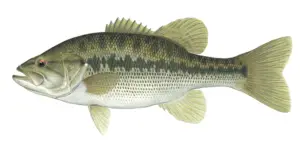 Spotted bass is a cousin to a largemouth bass and shares some similarities and differences.
Spotted bass is a cousin to a largemouth bass and shares some similarities and differences.
Both are extremely hard fighters and very fun to catch.
A spotted bass’ jaw does not reach over its eye line. The jaw of a largemouth bass is longer and extends over the eye line.
On a spotted bass, the dorsal fin is clearly attached and has a mild slope. The dorsal fin of a largemouth bass is separate, or nearly so. This is most likely the most important difference between the two species.
A connected irregular dark lateral line runs along the side of a Spotted Bass. There is no discernible lateral line in largemouth bass.
Drop shot, tubes, Ned rig, Neko rig, and Mojo rig (which is a modified split shot rig that won’t damage your line) around fallen trees or rock piles. Senko’s along with peanut butter and jelly colored jigs are a great color all year round.
General Spotted Bass Details
Spawn: March-May
Food: fish, crustaceans.
California State Record: 11 lbs 4 oz. Caught 2/12/2017 in New Bullards Bar Reservoir.
Table Quality: Similar to a largemouth bass it’s firm, white, flaky, mild-tasting
Angling techniques:
- Finesse jigs
- Mojo Rig
- Neko Rig
- Small crankbaits
- Football Jigs
- Soft plastic swimbaits
- Jerkbaits
- Chatterbaits
- Swim jigs
- Hair jigs
- Underspin jigs
- Drop shot plastic worms
- Tubes
- Streamer flies.
- Live baits: minnows, hellgrammites, and crayfish
White and Black Crappie
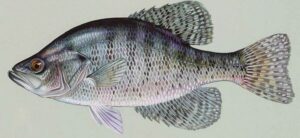 If you like crappie fishing, this lake is filled with them.
If you like crappie fishing, this lake is filled with them.
The best time to fish for crappie in this lake and other lakes similar to it is in summertime while you’re night using a submerged green light. If you don’t know what a green fishing light is, or if you’re unfamiliar, then click this link to learn more.
Green light fishing at night in this lake is amazing. If you haven’t done it you are missing out. The nights are cool and the night sky is filled with stars…
Anyway, I digress…
White crappie tend to linger over submerged brush and timber and are found in schools. The white crappie are much more tolerant in warmer water than their black crappie cousins.
White crappie have a more “silvery” appearance and lack the dark vertical bars when compared to the black crappie.
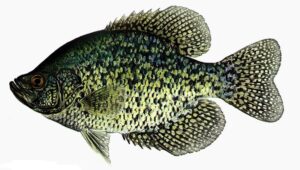 Black crappie can be described as having irregular black dots and blotches on the back and have more of a “silvery-olive” background.
Black crappie can be described as having irregular black dots and blotches on the back and have more of a “silvery-olive” background.
Average weight of a white or black crappie in this lake is probably going to be just under a pound.
General Crappie Details
Spawn: April – mid-June
Food: Larvae, small fish, and crustaceans. Threadfin shad and minnows make up their main diet.
California State Record:
- White crappie: 4 lbs 8 oz. Caught 4/26/1971 in Clear Lake using minnows.
- Black crappie: 4 lbs 8 oz. Caught 2/17/2021 in Clear Lake using minnows.
Table Quality: The meat is excellent. It’s firm, flaky and white.
Angling techniques:
- Live minnows under bobbers
- Crappie jigs
- Crappie tubes
- Silver spoons
- Spinners
Catfish
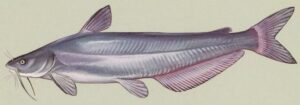 There are four species of catfish in California, the blue catfish, bullhead catfish, channel catfish, white catfish.
There are four species of catfish in California, the blue catfish, bullhead catfish, channel catfish, white catfish.
Catfish are predatory animals and scavengers. Some can get very big, while others remain small. They tend to spend most of their time on the bottom of the lake versus swimming higher in the water column suspended.
Catfish can have up to 8 whisker-like barbels by their mouths to help them detect food.
Blue catfish can get very big. They can weigh more than 100 pounds and grow to around 5 feet long. They have 8 whisker-like barbels by their mouths. They prefer larger cut bait and live bait
Conversely, bullhead catfish tend to be smaller and will weigh on average about 1-2-pounds, but can grow to around 4-5-pounds.
Channel catfish weight will range from 0.5-to-15-pounds in this lake, however the average weight will be between 1-4-pounds.
The smallest of all catfish in North America is the white catfish. These catfish are considered rare by anglers’ standards. They average 1-2 pounds and will grow to only about a foot.
All species prefer warmer coves, but can also be found scavenging near the marinas, or around the dam.
All can be caught with live bait, cut bait or dough bait. Some of the best baits you can use are chicken livers, hotdogs, anchovies, mackerel or sardines, catfish stink-bait/dough baits, or even night crawlers. warm coves or near the dam.
General Catfish Details
Spawn: March-June
Food: Carp, bluegill
California State Record:
Blue catfish – 72 lbs 14 oz. Caught 4/22/2003 in Colorado River (Riverside).
Bullhead catfish – 4 lbs 8 oz. Caught 10/7/1993 in Trinity Lake.
Channel catfish – 53 lbs 8 oz. Caught 9/22/2008 in San Joaquin River.
White catfish – 22 lbs 0 oz. Caught 3/21/1994 in Land Park pond (Sacramento).
Table Quality: Soft white meat. In the summer the meat will taste muddy.
Angling techniques:
- chicken liver
- hotdogs
- stink bait
- small live bluegill, sunfish, or perch
- Frozen cut bait; anchovies, mackerel or sardines.
Bluegill or Sunfish
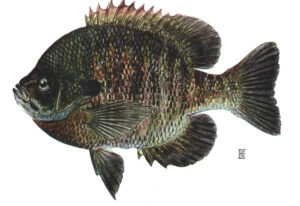 Also known collectively as “panfish” or “bream”, these small fish are both predators and prey. They fulfill a mid-tier predator role in the ecosystem.
Also known collectively as “panfish” or “bream”, these small fish are both predators and prey. They fulfill a mid-tier predator role in the ecosystem.
Panfish are highly aggressive and eat minnows, bass fry (newly hatched baby bass), and insects.
The bluegill has teal-blue coloring on the bottom portion of the chin and gill plate. It also has a solid black opercula flap just behind the gill plate.
Fun fact: The oldest reported age for a bluegill is 10 years.
With the exception of appearance and size, the redear sunfish is quite similar to the bluegill. The dorsal fin of the redear sunfish features tiny vertical bands that go downward. It has a black dorsal color and a yellow-green ventral tint. The male’s operculum has a cherry-red edge, while the female’s has an orange coloring.
These panfish are found on the shoreline and prefer nearby structures. They are incredibly aggressive and will quickly attack anything that looks like it could be eaten. Due to their aggressive behavior, they are one of the easiest fish to catch and are a great way to introduce someone to fishing.
General Bluegill/ Sunfish Details
Spawn: April and May
Food: Small fish and insects
California State Record:
Bluegill – 3 lbs 14 oz. Caught 6/22/2008 in Rancho Murieta Reservoir.
Sunfish (red ear) – 5 lbs 3 oz. 6/27/1994 in Folsom South Canal (Sacramento)
Table Quality: Firm, white meat
Angling techniques:
- Worms
- Dough balls
- Slim Jim sausages pieces on a small hook (not lying… it really works)
- Small spinners
- Trout flies
Yellow Perch
 Sometimes called the “raccoon perch”, or even “ringed perch”, yellow perch can be best described as having six to nine vertical black bars draped over its golden colored sides.
Sometimes called the “raccoon perch”, or even “ringed perch”, yellow perch can be best described as having six to nine vertical black bars draped over its golden colored sides.
Particularly on spawning males, the bottom fins flash with a bright orange brilliance, kinda like hot metal being pulled out of a kiln.
They are some of the most beautiful of all freshwater fish.
Perch are found on the shoreline and prefer nearby structures, and are incredibly aggressive and will quickly attack anything that looks like it could be eaten. Due to their aggressive behavior, they are easy to catch and taste amazing.
General Perch Details
Spawn: February thru July
Food: Small fish and insects
California State Record: 3 lbs 10 oz. Caught 5/22/1979 in Crowley Lake.
Table Quality: Firm, white meat
Angling techniques:
- Worms
- Dough balls
- Slim jim sausages pieces on a small hook (not lying… it really works)
- Small spinners
- Trout flies
Boat Ramps At Don Pedro Reservoir
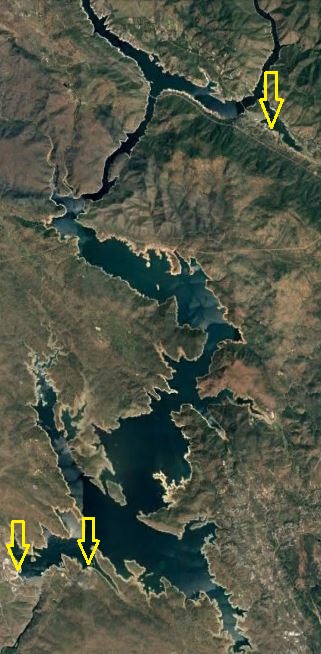
Lake Don Pedro Marina & Boat Ramp
- Location: south end of the lake
- Address: 11500 Bonds Flat Rd, La Grange, CA 95329
- Phone number: 1 (209) 852-2369
- Nearby boat ramp: Yes
- # of Boat ramp lanes: 5
- Groceries available: Yes with restaurant
- Gas: Yes
- Bathrooms: Yes
- Showers: Yes
- Electric: Yes
- Camping nearby: Yes
Moccasin Point Marina & Boat Ramp
- Location: North end of lake
- Address: 11405 Jacksonville Road. Jamestown, CA 95327-9587
- Phone number: 1 (209) 989-2205
- Nearby boat ramp: Yes
- # of Boat ramp lanes: 3
- Groceries available: Yes
- Gas: Yes
- Bathrooms: Yes
- Showers: No
- Electric: Yes
- Camping nearby: Yes
Blue Oaks Recreation Area
- Location: south end of the lake
- Address: 11500 Bonds Flat Rd. La Grange, CA 95329
- Phone number: 1 (209) 852-2369
- Nearby boat ramp: Yes
- # of Boat ramp lanes: 5
- Groceries available: Yes with restaurant
- Gas: Yes
- Bathrooms: Yes
- Showers: Yes
- Electric: Yes
- Camping nearby: Yes
Places At The Lake You Can Get Snacks And Frosty Beverages
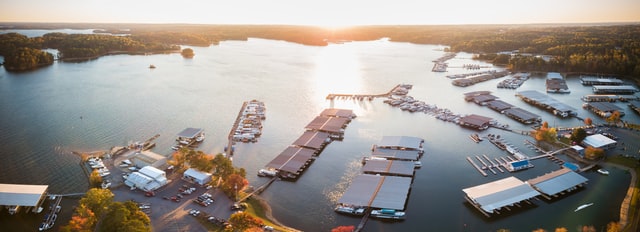
Lake Don Pedro Marina
- Location: south end of the lake
- Address: 11500 Bonds Flat Rd. La Grange, CA 95329
- Phone number: 1 (209) 852-2369
Moccasin Point Marina
- Location: North end of lake
- Address: 11405 Jacksonville Road. Jamestown, CA 95327-9587
- Phone number: 1 (209) 989-2205
Top Tackle Shops Near Or At Don Pedro Reservoir
Yosemite Adventure Supplies
- Address – 18911 Ferretti Rd bldg a, Groveland, CA 95321
- Phone number – 1 (209) 962-0923
- Payment methods accepted – Cash, credit, debit
Lake Don Pedro Marina
- Address – 11500 Bonds Flat Rd, La Grange, CA 95329
- Phone number – 1 (209) 852-2369
- Payment methods accepted – Cash, credit, debit
Moccasin Point Marina
- Address – 18911 Ferretti Rd bldg a, Groveland, CA 95321
- Phone number – 1 (209) 989-2205
- Payment methods accepted – Cash, credit, debit
Places to Camp, Lodging and RV Parks
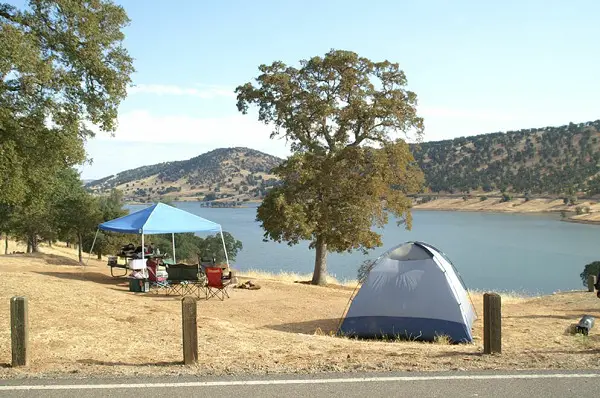
Fleming Meadows Recreation Area
- Sites – 266.
- RV – 90 full hook up
- Standard sites – 125
- Walk-in tent sites – 51
- Fish cleaning station present – Yes
- Availability – Year round
- Reservations – click here
Blue Oaks Recreation Area
- Sites -195.
- RV – 34 full hook up
- Standard sites or walk-in tent sites – 161
- Fish cleaning station present – Yes
- Availability – Year round
- Reservations – click here
Moccasin Point Campground
- Sites – 266.
- RV – 90 full hook up
- Standard sites – 125
- Walk-in tent sites – 51
- Fish cleaning station present – Yes
- Availability – Year round
- Reservations – click here
Boat-in camping areas (primitive)
- Graveyard Creek
- Wreck Bay
Other Activities You Can Do at Don Pedro Reservoir
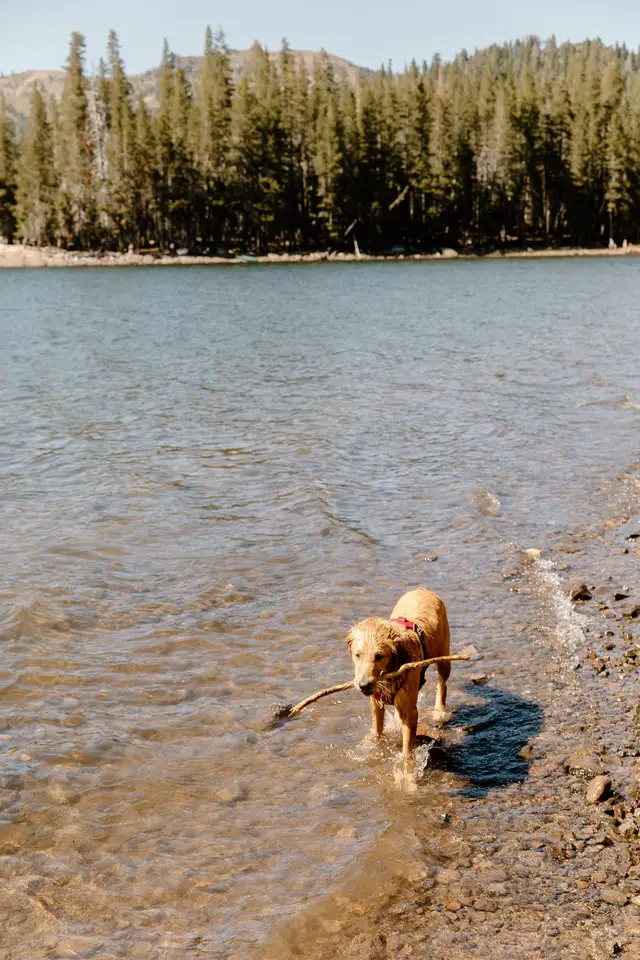
Fishing is not the only thing that brings people to this beautiful body of water. Here’s a list of other things you can do!
- Biking
- Bird watching
- Boating
- Skiing
- Kayaking
- Canoeing
- Paddleboarding
- Sailing
- Swimming
- Camping
- Horseshoes
- Picnicking
- Hiking
- Gentle walking trails
- Nature photography trails
- Wildlife viewing
- Mountain biking
- Stargazing
- and most importantly… relaxing.
Other California Related Fishing Articles
- Bass Lake Fishing Report
- Clear Lake Fishing Report
- Castaic Lake Fishing Report
- California Delta Fishing Report
- Diamond Valley Lake Fishing Report
- Don Pedro Reservoir Fishing Report
- Eagle Lake Fishing Report
- El Capitan Reservoir Fishing Report
- Lake Berryessa Fishing Report
- Big Bear Lake Fishing Report
- Folsom Lake Fishing Report
- Irvine Lake Fishing Report
- Lake Almanor Fishing Report
- Lake Camanche Fishing Report
- Lake Isabella Fishing Report
- Lake Havasu Fishing Report
- Lake McClure Fishing Report
- Lake Oroville Fishing Report
- Lake Perris Fishing Report
- Lake Piru Fishing Report
- Lake Skinner Fishing Report
- Lake Tahoe Fishing Report
- Los Banos Reservoir Fishing Report
- New Hogan Lake Fishing Report
- New Melones Lake Fishing Report
- O’Neill Forebay Fishing Report
- Pardee Lake Fishing Report
- Pyramid Lake Fishing Report
- San Luis Reservoir Fishing Report
- San Vicente Reservoir Fishing Report
- Shasta Lake Fishing Report
- Silverwood Lake Fishing Report
- Trinity Lake Fishing Report
- Whiskeytown Lake Fishing Report
More articles just for you...
Funny Fishing Rules, Laws, and Regulations 2025
Crazy Fishing Laws That Will Blow Your Mind! #7 is INSANE! Strange Fishing Regulations and Laws As silly as hook and rod limits may seem,
EXPOSED! How To Use A Spinnerbait The Right Way for 2025
Are You Wondering How To Use A Spinnerbait? Or How To Work A Spinnerbait Over Grass, Logs, or Points? Well, All These Questions Are Answered
EXPOSED! Best Crankbait Colors for 2025 [Which to Buy & Avoid]
What color crankbait to use? Crankbait Color Chart I just love going into a Bass Pro Shops store and just staring at all the walls
Best Underwater Dock Lights For Fishing – 2025 Buyers Guide
Night Dock Light Fishing For Beginners Dear fellow angler, Does this sound like you? You’re someone who loves fishing but just wants to escape the
15 Best Deep Diving Crankbaits [2025 Buyers Guide – Which to Buy & Avoid]
A Complete Buyer’s Blueprint On The Best Deep Diving Crankbaits for Bass, Walleye, or Striped Bass On The Market Today Fishing deep diving crankbaits can

